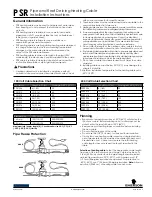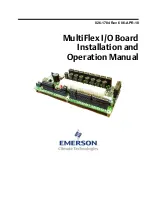
31
User Manual - Stand-Up Lift: WAYUP 5 Range
Manufactured by NAUSICAA Médical S.A.S. / Approved by Ghizlane Labrosse (Biomedical Engineer)
Troubleshooting Guide
Main symptom
Refined symptom
Cause
Solution
The unloaded device does not always go
down.
The device runs empty.
Our devices need to have a weight exerted
on them in order to be lowered.
Push down on the lifting arm while pressing
the down button on the remote control.
The moving parts of the devices are hard,
the device is hard to handle.
Problem of rolling, of knee supports
adjustment.
This is due to a lack of lubrication of the
moving parts.
Lubricate the moving parts.
The batteries are discharged or worn out. Charge the device or change the batteries.
The motherboard is defective.
Change the motherboard.
Battery level off while pressing the remote
control.
Actuator cable is not connected or
damaged.
Reconnect the actuator cable or if it is
damaged, repair it.
Battery is charged on direct current
(flashing battery level display) but no
display on the control box if it is
disconnected from the direct current.
Emergency stop button is pressed or
defective.
Disengage the emergency stop button or
change it.
The contact between the battery and the
control box is not present.
Remove and replace the battery, making
sure that the two parts are in contact.
The battery is too worn or too discharged to
be recharged.
Change the battery.
One of the fuses T10A (one in the control
box and one in the battery cartridge) is cut.
Replace the faulty fuse(s).
Battery is charged on direct current
(blinking battery level display) and normal
display on the control box if it is
disconnected from the direct current.
The remote control is out of service (check
if the device works with the buttons on the
control box).
Change the remote control.
In all other cases.
The motherboard is defective.
Change the motherboard.
The batteries are discharged or worn out. Charge the device or change the batteries.
The weight lifted by the device is too
important, a weight symbol is displayed on
the screen.
Decrease the weight lifted by the unit by
relieving the load on the lifting arm.
The duty cycle of the actuator is reached
(self-preservation), an actuator is displayed
on the screen.
Do not use the device for at least 20
minutes.
The thermal protection of the actuator has
been activated.
Allow the actuator to cool down.
The batteries are discharged or worn out.
Charge the device or change the battery.
The motherboard is defective.
Change the motherboard.
On direct current, the battery level flashes
then becomes fixed in a short time (<5
hours for a fully discharged battery).
The batteries are worn.
Change the battery.
The batteries are worn.
Change the battery.
One of the fuses T10A (one in the control
box and one in the battery cartridge) is cut.
Replace the faulty fuse(s).
Check that the electrical outlet is functional.
Changer de prise de courant
Check if the power cord is not damaged.
Change the power cord.
One of the T1A fuses is cut
(on VEOBOX 1 and 2)
Replace the faulty fuse(s).
The internal case charger is out of service
(on VEOBOX 3).
Change the internal charger.
The motherboard is defective (on VEOBOX
1 and 2).
Change the motherboard.
On direct cuurent, the battery level does
not blink, it becomes fixed right away.
The battery no longer holds the charge.
Device empty and/or being lowered
On direct current, nothing happens.
The actuator does not work but we hear a
"click" in the control box when pressing the
remote control.
The actuator does not work and there is no
"click" sound in the control box when the
remote control is pressed.
Battery level remains displayed on the pack
even while pressing on the remote.
Battery recharged to the direct current
(battery level display on 4 bars) but no
display on the control box if it is
disconnected from the direct current.
Only when the patient is hanging from the
sling during the lifting movement.
The actuator stops intermittently.






































